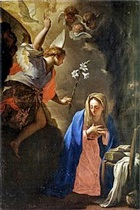

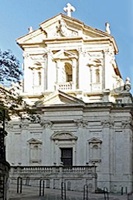
Bishop Napoleone Comitoli invited the Oratarian Fathers to Perugia in 1614. They settled for a short time in the Case della Parrocchia of the recently-suppressed parish of San Bartolomeo (later the Chiesa della SS Annunziata). However, Bishop Comitoli soon gave them a large piece of land here bounded by Via dei Priori, Via della Stella, Via Antonio Fratti and Via Ritorta. They initially used an early Christian baptistery on this site that was known as San Giovanni Rotunda, which they later demolished. In 1624, they also acquired the nearby parish church of San Gregorio. They then began the construction of the present church, which is formally known as the Chiesa dell' Immacolata Concezione e di San Filippo Neri and which is also known as Chiesa Nuova. Its design by Paolo Maruscelli is based on that of the Oratorians' mother house, Chiesa Nuova (also called Santa Maria in Vallicella), Rome.
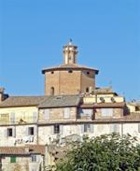
Bishop Marcantonio Oddi financed the construction of the facade in 1662-5. (He had wanted to finance the facade of the Duomo but had been rebuffed by the Canons).
The Oratorian Fathers built the nearby Oratorio di Santa Cecilia in 1687-90 on land that they acquired from Andrea Sciri. It was purpose-built for musical devotion, to a design by Pietro Baglioni, and dedicated it to St Cecilia, the patron saint of music. The Oratorians commissioned an altarpiece (1688) of the Madonna and Child with SS Cecilia and Philip Neri from Carlo Lamparelli for the altar wall of the oratory.
Further work was carried out on the church in the 18th century:
-
✴The small square outside its entrance was cleared in 1736.
-
✴The steps (1665) leading to the main entrance, which had unfortunately been built over a well, had to be rebuilt in 1772 (and again in the early 20th century).
-
✴The original campanile was inaugurated in 1779. (It was demolished in 1930, when the present, higher campanile was built).
The parishes of San Giovanni Rotunda and San Gregorio were formally united with that of San Filippo Neri in 1772, and their churches were subsequently demolished.
San Filippo Neri itself fell into a poor state in the late 20th century, and has recently been restored.
Interior
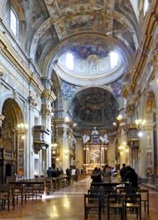
The interior has a barrel vaulted single nave and lateral chapels, a fine cupola over the crossing and a semi-circular apse. It is richly decorated with frescoes from the 17th and 18th centuries.
Apse, Crossing and Nave
Immaculate Conception (1658-62)
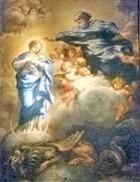
The altarpiece has unusual iconography, in which God creates the Virgin using the gesture that Michelangelo used in his famous fresco (1509-12) of the creation of Adam in the ceiling of the Sistine Chapel. The Virgin stands on a cloud above a vanquished dragon that represents original sin. This altarpiece has been recently restored.
Frescoes in the Vault of the Apse (1668-9)
These damaged frescoes by Giovanni Andrea Carlone are set in a decorative frame by Nicolò Giuli. They depict scenes that relate to the theology of the Immaculate Conception of the Virgin. For example, the scene directly above the curved altar wall depicts Esther pleading with the Persian King Ahasuerus for the lives of the Jews in his empire: theologians regard Esther as a prefiguration of the Immaculate Virgin.
SS John the Baptist and Gregory the Great (1674)
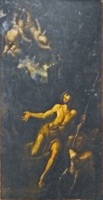
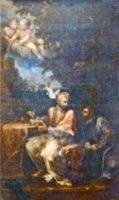
According to the guide to Perugia written by Serafino Siepi in 1822, these panels in the apse were commissioned from Pietro Montanini to mark the 50th anniversary of the unification of the parishes of San Giovanni Rotunda and San Gregorio with that of San Filippo Neri.
Coronation of the Virgin (1728-30)
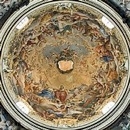
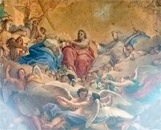
This fresco in the cupola by Francesco Mancini depicts the figures of the Trinity crowning the Virgin.
Four Evangelists (1668-9)
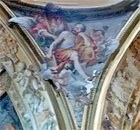
Scenes from the Apocalypse (1762)
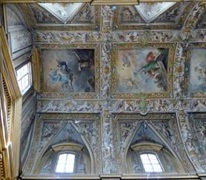
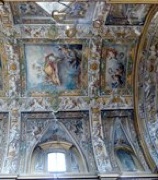
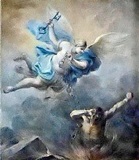
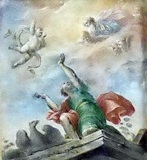

These frescoes in the vaults of the nave by Francesco Appiani are set in a decorative frame. The three main scenes depict (from the counter-facade):
-
✴the Angel of the Apocalypse;
-
✴St John on Patmos receiving his vision of the Apocalypse; and
-
✴woman clothed with the sun, with the moon beneath her feet.
Cappella del Crocifisso
This chapel is in the left transept.
Frescoes (1737)
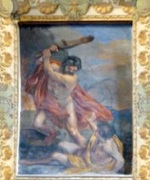
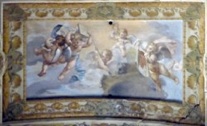
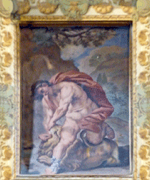
The frescoes in the arch above the Cappella di San Filippo (in the right transept), which are by Sebastiano Ceccarini of Urbino, are set in decorative chiaroscuro frames by Paolo Brizi. The fresco at the centre depicts angels carrying the instruments of the Passion, while those to the sides depict scenes from the Old Testament:
-
✴Samson killing a lion; and
-
✴Cain killing Abel.
Cappella di San Filippo Neri
This chapel is in the right transept. A relic of the heart of St Philip Neri is preserved on the altar.
Frescoes (1735)
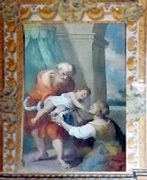
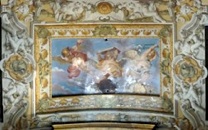
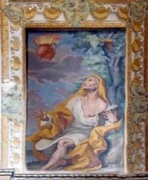
The frescoes in the arch above the Cappella di San Filippo (in the right transept), which are by the ageing Giacinto Boccanera, are set in decorative chiaroscuro frames by Paolo Brizi. The fresco at the centre depicts angels with symbols of the Virtues, while those to the sides depict scenes from the Old Testament:
-
✴Elijah and the widow of Zarephath; and
-
✴Jeremiah contemplating a phoenix, which prefigures the resurrection of Christ.
Vision of St Philip Neri (17th century)
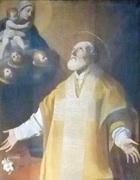
Chapels in the Nave
The dedications of the chapels constitute a coherent Marian programme, proceeding anti-clockwise from the 3rd chapel on the left.
Cappella della Natività di Maria
This is the 3rd chapel on the left. Its original altarpiece (1643) of the Birth of the Virgin by Pietro da Cortona is described below (see Art from the Church).
Stigmatisation of St Francis (17th century)
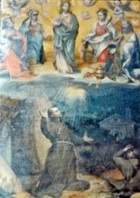
Frescoes (1636-42)
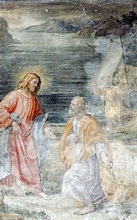
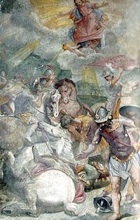
Calling of St Peter Conversion of St Paul
These frescoes by Antonio Maria Fabrizi depict:
-
✴in the vaults:
-
•God the Father; and
-
•two scenes from the life of Jacob:
-
-his dream of a ladder to Heaven; and
-
-his fight with an angel, after which his name was changed to “Israel”; and
-
✴on the walls (illustrated here):
-
•the calling of St Peter; and
-
•the conversion of St Paul.
Cappella della Presentazione di Maria
This chapel (also known as Cappella Biggazini) is the 2nd chapel on the left. Its original altarpiece (ca. 1665) of the Presentation of the Virgin by Luigi Pellegrino Scaramuccia is described below (see Art from the Church).
Frescoes (1668-9)
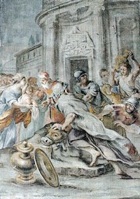
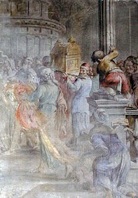
Samuel sacrifices at the Temple David entrusts the Ark of
the Covenant to Obed-Edom
These frescoes by Giovanni Andrea Carlone depict:
-
✴in the vaults:
-
•Noah releases a dove from the arc;
-
•Abraham leaves for Canaan; and
-
•David receives divine blessing before his war to liberate Bethlehem; and
-
✴on the walls (illustrated here):
-
•Samuel sacrifices at the Temple; and
-
•David entrusts the Ark of the Covenant to Obed-Edom.
Cappella dell’ Annunciazione
This is the 1st chapel on the left.
Annunciation (1710)
Cappella della Visitazione
This is the 1st chapel on the right.
Visitation (1709)
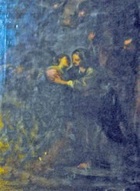
Cappella della Purificazione
This is the 2nd chapel on the right. Its original altarpiece (1651) of the Purification of the Virgin by Andrea Sacchi is described below (see Art from the Church).
Frescoes (1649)
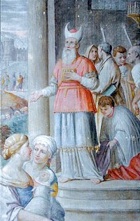
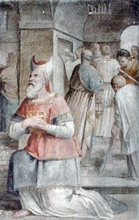
St Simeon waits for the Virgin St Simeon gives thanks
These frescoes by Bernardino Gagliardi depict:
-
✴in the vaults:
-
•the Holy Spirit, represented by a dove;
-
•Moses with the Law of God; and
-
•David playing the harp; and
-
✴on the walls, two scenes (illustrated here) that complement the theme of the original altarpiece (1651) of the Purification of the Virgin by Andrea Sacchi:
-
•St Simeon waits for the Virgin at the Temple; and
-
•St Simeon gives thanks after the service.
Cappella dell' Assunzione
This is the 3rd chapel on the right. Its original altarpiece (1637) of the Assumption of the Virgin by Guido Reni is described below (see Art from the Church).
Coronation of the Virgin (17th century)
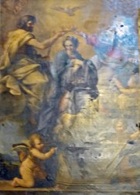
Frescoes (1632-5)
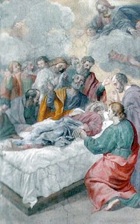
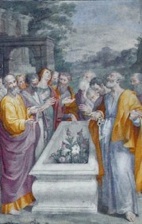
Death of the Virgin Apostles and the empty grave
These frescoes by Antonio Maria Fabrizi depict:
-
✴in the vaults, the cloud that represents God, surrounded by musical angels; and
-
✴on the walls, two scenes (illustrated here) that complete the story that was depicted in the original altarpiece of the Assumption of the Virgin by Guido Reni:
-
•the Death of the Virgin; and
-
•the Apostles around her empty grave .
Sacristy
The sacristy is to the left of the apse.
Frescoes in the sacristy (18th century)
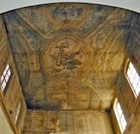
Immaculate Virgin with saints (ca. 1605)
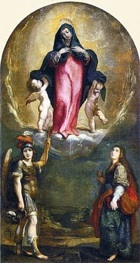
Works Removed from the Church
The original altarpieces (17th century) on the side altars formed a Marian cycle and were commissioned from some of the finest artists working in Rome. Unfortunately, they were later removed, and many have been lost.
Assumption of the Virgin (1637)
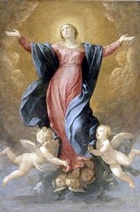
A copy (18th century) of this altarpiece by Anton Maria Garbi, which was originally in San Filippo Neri, Montefalco, is now in the Pinacoteca there.
Birth of the Virgin (1643)
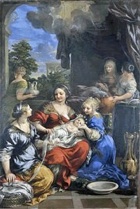
Purification of the Virgin (1651)
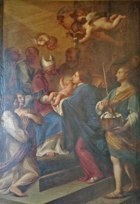
Presentation of the Virgin (ca. 1665)
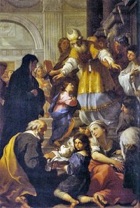
Read more:
“La Chiesa Nuova o dell’ Immacolata Concezione e di San Filippo Neri in Perugia: Storia, Pittura e Restauro”, (2008) Perugia
E. Ricci, “La Chiesa del’ Immacolata Concezione e di San Filippo Neri (Chiesa Nuova) in Perugia”, (1969) Perugia
Return to Monuments of Perugia.
Return to Walk III.
